
|
|

May 7, 2010
WSTR and WQXI, Atlanta, 2009
There are some cities where it's our habit to visit in a leisurely fashion; later this summer, for instance, we'll be spending the better part of a week in Boston, mixing radio fun with some of our other hobby interests. Then there are cities that, for whatever reason, seem to prompt a rush of activity. Later this year here on Site of the Week, you'll see the results of a whirlwind two-day train trip from Rochester to Chicago last June to see that market's analog TV just days before it went away.
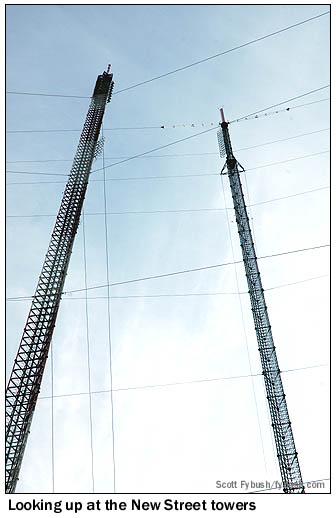 Another
market that always seems to get jam-packed with activity for
us is Atlanta. Maybe it has something to do with the often dirt-cheap
plane tickets that make it easy for a quick getaway, or maybe
it's something about the friendly radio folks who go out of their
way to show off the market - but in any event, our February 2009
trip to Atlanta was another nonstop whirl of studios and transmitter
sites, much like our last two-day visit back in 2004 (chronicled
here
and in three previous 2005 installments.)
Another
market that always seems to get jam-packed with activity for
us is Atlanta. Maybe it has something to do with the often dirt-cheap
plane tickets that make it easy for a quick getaway, or maybe
it's something about the friendly radio folks who go out of their
way to show off the market - but in any event, our February 2009
trip to Atlanta was another nonstop whirl of studios and transmitter
sites, much like our last two-day visit back in 2004 (chronicled
here
and in three previous 2005 installments.)
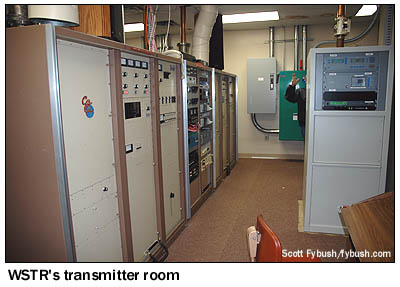
This trip didn't even require the usual schlep to the rental car counter, what with our Atlanta travel guide Roddy Freeman waiting at the curb for us. (Among other things, Roddy's the proprietor of the Atlanta Airwave Action blog, which nicely chronicles the Peachtree radio scene.)
Our first stop this sunny February morning is on the east side of town, on a little dead-end street called New Street - a street that dead-ends, to be precise, at a gate that leads into a transmitter compound that's home to two tall towers, several FM stations and one public TV outlet.
These towers belong to the Atlanta Board of Education, whose radio station (WABE 90.1) and TV station (WPBA, analog 30/digital 21) call the tower on the right home. That's the newer of these two towers, having gone up here in 2004 to join the 1062-footer on the left that went up here in the late 80s. The hefty master FM antenna near the top of that tower carries several of Atlanta's big FMs: Cox's WSB-FM (98.5), CBS Radio's WVEE (103.3) and the one we've come to see, Lincoln Financial Media's WSTR (94.1).
The "Star 94" transmitter is in one of several small rooms in the concrete-block building near the tower base, and it's a very neat, clean space configured with a pair of 35 kW Continental 816s for analog and a Harris Z-series transmitter for digital. Those boxes feed a distributed combiner system that eventually channels all three big FMs up to the Alan Dick panel antenna a thousand feet up. At least in WSTR's case, this is actually a dual-antenna system - each of those Continentals normally hums along at half-power with one feeding the upper set of bays on the panel antenna and the other feeding the lower bays; if one half of the transmission system fails, the other half can run at full power. (This site is also home to auxes for CBS Radio's WZGC 92.9 and for WVEE, feeding that side-mounted antenna lower down.)
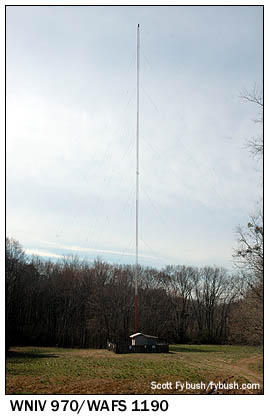
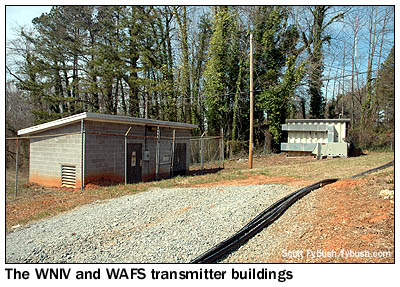 After
a tour of this facility, our next stop is lunch (hot dogs, of
course, at the Varsity Jr. just off Cheshire Bridge Road, northeast
of downtown Atlanta), followed by a visit to WSTR's AM sister
station, WQXI (790).
After
a tour of this facility, our next stop is lunch (hot dogs, of
course, at the Varsity Jr. just off Cheshire Bridge Road, northeast
of downtown Atlanta), followed by a visit to WSTR's AM sister
station, WQXI (790).
WQXI is one of five AM stations in close proximity along Cheshire Bridge Road. There's Salem's WGKA (920), with a tall tower right on Cheshire Bridge, the relatively new WMLB (1690 Avondale Estates) across the street in the middle of a trucking yard, and the cluster of towers we've come to see: WQXI's four-tower array just east of WGKA, and one more tower to the south of the 790 array. That's the tower shown to the left, shared by WNIV (970) and WAFS (1190), and those are the 970 and 1190 transmitter buildings above - only by now, we're not on Cheshire Bridge Road anymore, because these sites are actually reached from the east, off Lenox Road NE.
Construction along Lenox has blocked the driveway that usually leads back to the WQXI site, so we take a short walk through the pines and across the railroad tracks to get to the field where WQXI's transmitter building sits in the middle of the array, elevated way up above the floodplain where the towers are located. (And yes, it definitely does flood here!)
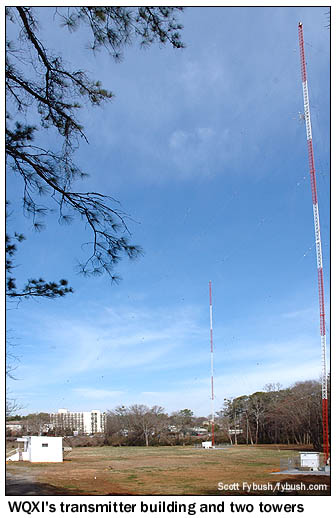
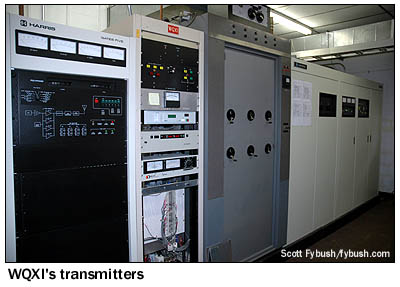
WQXI came on the air in 1948 as part of the explosion of post-war radio, and for many decades was owned by the colorful character Robert Rounsaville, whose chain of stations spanned much of the South.
The station's heyday came in the sixties and seventies, when it ditched its country format to become "Quixie in Dixie," the biggest top-40 station in a market that boasted several impressive contenders. None of those stations boasted very good signals, though - WPLO (590) was by far the best, then running 5000 watts day and night from a site not far from here (we'll see its present facility later in our 2009 tour); WAKE (1340) was a 250-watt graveyarder; and WQXI put out 5000 non-directional daytime watts, then dropped down to 1000 watts from a very restrictive pattern at sunset.
Despite those limitations, WQXI thrived in the AM top-40 era, launching a slew of top talents that included Scott Shannon and a guy named Hugh Wilson, who took many of his experiences at Quixie with him when he started writing a new TV show in the late 70s. Many of the plotlines of your favorite episodes (and mine) of "WKRP in Cincinnati" are based on real-life events at WQXI.
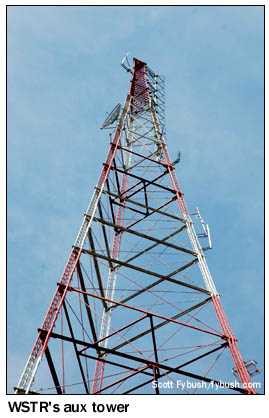 With
the decline of AM music in the 80s, WQXI flitted through several
formats - satellite oldies, standards, "KidStar" children's
radio - before landing on sports as "790 the Zone,"
and that's what it is today.
With
the decline of AM music in the 80s, WQXI flitted through several
formats - satellite oldies, standards, "KidStar" children's
radio - before landing on sports as "790 the Zone,"
and that's what it is today.
On the technical side, this site went through a significant upgrade in 2008, as years of overgrowth were cleared out, a new ground system went in, and the daytime tower was upgraded to handle a power increase to 28 kW, fed by that new DX50 at the end of the row in the transmitter building. (At night, it's still the old 1 kW directional facility, which misses much of the east side of the now-sprawling market.)
During the first years of WQXI's AM heyday under Rounsaville, the station had no FM companion (though there were two stations that bore the WQXI-TV calls, a short-lived UHF outlet on channel 36 in the 50s and later the ABC affiliate on channel 11 that had been AVCO's WLWA and is today's NBC affiliate, WXIA-TV.)
When WQXI did get an FM sister in the sixties, it was a signal that had been licensed to suburban Smyrna. WSMA-FM (94.1) was a sister station to WSMA (1550) before being sold off to WQXI, which changed the calls to WKXI. In 1966, WKXI signed on from a new 413-foot tower on Bishop Street, in the Loring Heights neighborhood north of downtown Atlanta. In the seventies, with new calls of WQXI-FM, 94.1 moved right in to downtown, taking up residence on the top of the new Westin Peachtree Plaza Hotel, another site we'll see later in this trip.
And in 1989, 94.1 moved once more, out to the New Street tower we showed you at the top of this page, where it soon changed calls once more to WSTR, today's "Star 94." But the original 1966-vintage Bishop Street tower remained in place all the way through as an auxiliary facility, and it's still there to this day as a useful backup site to New Street. It doesn't get much use, thanks to that dual-main capability at New Street, but if power fails there or if there's tower work going on, it's nice to have a plan B, isn't it?
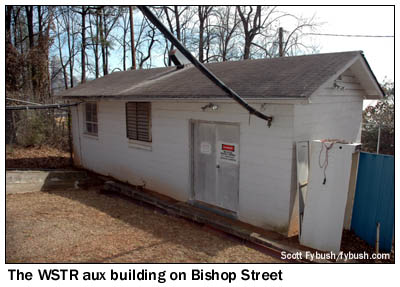
|
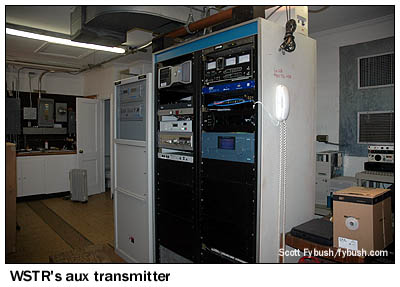
|
There's one more piece of this AM/FM combo yet to see, and that's the studio, located in the penthouse of the Blue Cross office building on an upscale stretch of Peachtree Road in Buckhead, a couple of miles north of the AM site.
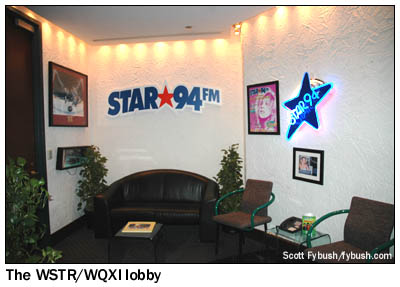
|
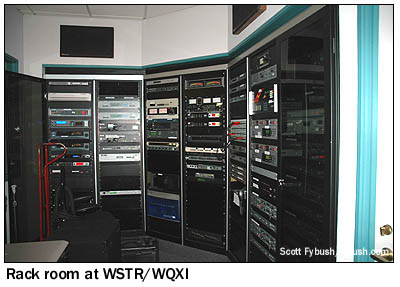
|
Atlanta never consolidated ownership to quite the same extent as many other large markets, which means it never got the same mega-cluster studios that the Clear Channels and CBS Radios built elsewhere. (Clear and CBS are both represented in the market, albeit with smaller clusters, and so are Cumulus, Radio One, Citadel and several other players.) Instead, WSTR and WQXI ended up in the hands of Jefferson-Pilot Broadcasting, which gave way to today's Lincoln Financial Media.
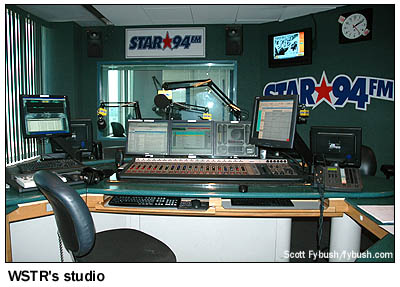
|
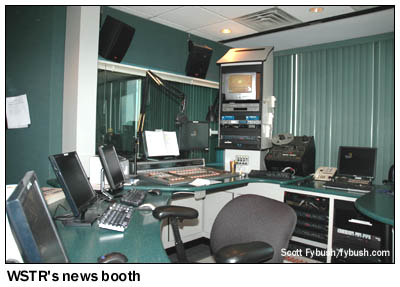
|
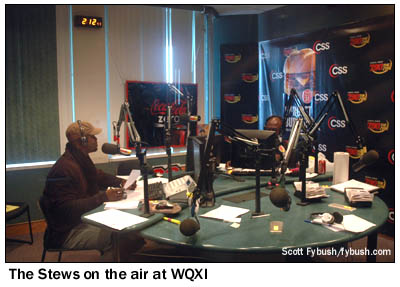 LFM
operates Star 94 as a top-40 station, and it leases out WQXI
to Big League Broadcasting, which programs the "790 the
Zone" sports format from the studios right across the hallway
from Star. (Atlanta-based Big League also owns a sports station
of its own in St. Louis, KFNS, but oddly enough it leases out
that outlet to yet another sports programmer.)
LFM
operates Star 94 as a top-40 station, and it leases out WQXI
to Big League Broadcasting, which programs the "790 the
Zone" sports format from the studios right across the hallway
from Star. (Atlanta-based Big League also owns a sports station
of its own in St. Louis, KFNS, but oddly enough it leases out
that outlet to yet another sports programmer.)
Star has a nice two-studio air configuration with a big control room that looks into a fairly spacious news booth that's a big part of the morning show.
Across the hall, there's a similar two-studio configuration for WQXI - and in the Zone's main air studio we find the "Two Live Stews" afternoon show, which originated as a local Atlanta offering and ended up as a nationally-syndicated show, first via Radio One and now as part of Sporting News Radio, though still broadcasting most days from the studios right here in Atlanta.
This facility is also home base for Lincoln Financial Media's director of engineering, Barry Thomas, who's well-known to many in the engineering community for his work in New York and Los Angeles and with the Society of Broadcast Engineers.
For us, this visit to Lincoln Financial's stations is just the start of our two-day romp across Atlanta - join us next week as we visit Turner Broadcasting and head to the roof of one of Atlanta's tallest buildings!
This Tower Site of the Week installment comes with audio over at TopHour.com, where (starting Wednesday) you can hear a whole bunch of 2009 IDs from Atlanta - and in the meantime, we urge you not to miss your chance to grab one of the dwindling remaining stash of the all-new Tower Site Calendar 2010, just in time to fill that space on the wall where your 2009 edition once hung.
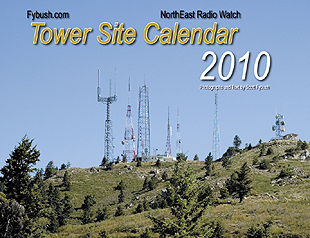 (It's
more than just pretty pictures and dates - the modest sum we
raise from each year's calendar helps make possible the travel
needed to make this feature happen every week on the website...and
we're grateful for all your support!)
(It's
more than just pretty pictures and dates - the modest sum we
raise from each year's calendar helps make possible the travel
needed to make this feature happen every week on the website...and
we're grateful for all your support!)
- Previous Site of the Week: WXKS/WRCA/WUNR, Boston
- In Two Weeks: Atlanta, 2009, part II
- Site of the Week INDEX!
- How can you help support Site of the Week? Click here!
- Submit your suggestions for a future Site of the Week!
